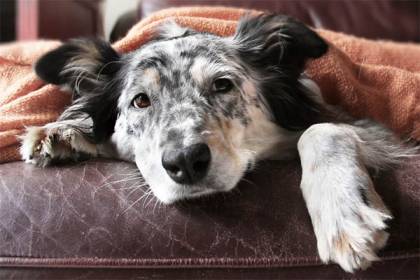Dogs share many common health issues with their pet parents including back problems such as IVVD (Intervertebral Disc Disease in Dogs), also called a slipped disc. Not only can this be a very painful condition, it can even lead to paralysis.
Connect with a verified veterinarian in minutes. Licensed vets are available 24/7 to answer your questions. No need to worry about your furry family member.
What is IVDD & What Causes It?
IVDD affects the discs of the spine, which are cushions found between each f the vertebrae. The purpose of the discs is to provide a cushion that works to absorb shock and protect the spinal cord from injury and damage. They also allow the back to move up, down and sideways while keeping the vertebrae separated and protecting the spinal cord. Discs are made of an outer ring that fibrous, while the inside of the disc is more like a gel. Sometimes the discs bulge or burst through the outer ring, and pinch the spinal cord, leading to nerve damage, nerve pain, and possibly paralysis.
In response to the damage and nerve compression, the muscles around the disc may become extremely tight as they try to stabilize the area.
There are two types of IVDD in dogs including:
- Type I: most common in the neck region in smaller breeds of dogs. This is when the outer ring become hard or calcified, making it easy for the disc to break. The disc can then burst and it’s inner material presses on the spinal cord.
- Type II: this occurs when the discs have become hard and fibrous over a long period. They may eventually break down, bulge out, pinching the spinal cord.
IVDD can affect any breed of dog, but is most common in:
- Dachshunds
- Pekingese
- Poodles
- Shih Tzus
- Beagles
- Bulldogs
- Corgis
- Bassett Hounds
- Cocker Spaniels
This list includes does that have short legs and long bodies; however, other breeds can also be affected including:
- Labrador Retrievers
- German Shepherds
- Doberman Pinschers
- And dogs that are overweight or obese
This painful medical condition can be caused by a jump or bad landing that cause the disc to burst. It can also develop naturally over time.
Symptoms of IVDD (Slipped Disc)
Symptoms of a slipped disc will vary from mild to severe, and can include the following:
- Dragging one or more limbs
- Hunched back
- Tucked abdomen
- Lameness or stumbling (your pup may look like he’s drunk when walking)
- Lowered head
- Difficulty turn the head
- Inability to walk or stand
- Doesn’t want to move or inability to move
- Trembling
- Sensitive to touch (your dog may whine, cry or even snap when the area is touched)
- Loss of control over urination and/or defecation
Symptoms will depend on which disc is herniated and its location in the spine. Dogs with a slipped disc in their neck may have trouble moving their head and neck. If the disc is in the lower back, your fur baby’s front legs may be OK, while he has trouble with his hind legs, even dragging them behind when walking. If IVDD is caused by wear and tear on the disc over time, you may notice symptoms gradually come on. On the other hand, if the damage is done all of a sudden, you’ll probably notice your pup is having trouble soon after jumping or another action.
If left untreated or not treated soon after injury, a dog can end up being paralyzed permanently.

Review symptoms, medications & behavior to keep your pets healthy with a Vet Online in just minutes.
Ask a Vet Live NowDiagnosis & Treatment
When you take your fur baby to the vet, they will probably ask you many questions, such as when did you first notice the symptoms, did the symptoms appear right after a specific action, what was the action, and more. After this, the vet will do a thorough physical exam of your dog, which will include a neurological exam, too. The vet will check your canine companion’s reflexes, motor function, response to manipulation (legs and feet) and if he’s able to stand and walk well. If your dog seems to have a mild case of IVDD, the vet will more than likely choose to treat this with anti-inflammatory medication, muscle relaxers and rest. The vet will be quite specific about the period that your dog must rest, which can be up to 6 weeks. This means no walks, no running and no jumping. You may also need to use the leash talking your fur baby outside to go potty. The vet may also advise you to keep your fur baby crated most of his recovery period.
If your dog seems to have a more severe case of IVDD, the vet may refer you to a veterinary neurologist or a veterinary surgeon. Your dog may require an MRI, which will be done under anesthesia. He may also need a myelogram, which is when a radioactive dye is injected into the area around the spinal cord. X-rays are then taken to better see the area of the slipped disc. In some cases, your fur baby may require surgery to relieve the pressure on his spinal cord. This type of surgery involves opening the back where the problem disc is located. Then, the vet drills through the bone and removes the inner material of the disc, which is causing the spinal cord compression. This surgery can take anywhere from 1 to 3 hours.
After the surgery, your dog may need to be hospitalized for a couple of days. During dog herniated disc surgery recovery, your pup will be monitored to make sure recovery is going as it should. While the surgery is usually successful, your dog may not regain complete function of all his limbs. It just depends on how severe the damage was to his spinal cord. A complete recovery can take up to several months. During that time, after the initial recovery period, the vet may prescribe doggie physical therapy.
What’s the Average Cost for This Type of Surgery?
Intervertebral disc disease dog surgery cost on average can cost anywhere between $1,500 to $4,000. Images taken to diagnose this painful condition can cost about $1,000 to $3,000 (MRIs, for instance).
Can IVDD be Treated Without Surgery?
Yes, it’s possible to treat dog slipped disc recovery without surgery, depending on the severity of the injury. Your vet may prescribe medications to reduce pain and swelling, and may prescribe physical therapy for your fur baby, too. In addition, heat or cold packs can help relieve the pain and swelling, and gentle massage can also help to get your pup back on his feet. Again, IVDD dog treatment without surgery will depend on the severity of your dog’s symptoms. If he has a severe type of injury, then he will probably need to have surgery.
How to Prevent IVDD
This condition isn’t always preventable, but there are things you can to minimize your fur baby developing this painful health issue. If your fur baby’s overweight, then it’s a good idea to consult with the vet about putting your dog on a diet. Keeping his weight under control can take some of the pressure off his neck, back and limbs, and your canine companion will also find it easier to get around. You can also keep your dog from jumping up, down or off furniture and stairs. There are ramps available to help dogs with a slipped disc, and other health issues, to manage getting on the couch, or even up into the car. Here’s a ramp that may help your dog. It’s called the Pet Gear Stramp Stair and Ramp Combination. This is a great option for helping dog get up and down. The ramp features carpet, which is easier for your dog to grip with his nails, giving him some extra traction. This ramp can be used in the house or even for the car!
If your fur baby has a problem with his neck, then it’s a good idea to make the switch from a collar to a comfortable harness. This will help to take some of the pressure off your pup’s neck when out for a walk. Here’s a harness that could be a good option for your fur baby. The Doggie Stylz Multi-Functional Full-Body Lifting Dog Harness Vest. The vest will help dogs that are having trouble managing stairs and other obstacles. It can be sued to provide front-only, rear-only, or combined full body supper. And it can be used as an everyday harness. It’s a great option for helping your dog get around while he’s recovering from a mild IVDD injury or after IVDD surgery.
Can’t Afford IVDD Surgery
If your fur baby needs to have surgery, but you can’t afford to pay for it, discuss this with the vet. Be open about the issue. First, you can ask if there are non-surgical treatments that would work. If the vet says that’s not possible, then try these methods:
1). Ask if the vet has a payment plan available, or if they’re willing to let you pay for your dog’s surgery over time. Most vets are happy to accommodate their clients, as long as you’re in good standing. The vet may allow you to make weekly or monthly payments that fit your budget.
2). Offer to help at the clinic by doing jobs such as cleaning kennels, answering phones, or other work.
3). Another option is to use a vet in a less expensive area. Vets in small towns and rural areas generally charge lower fees compared to vets in large cities.
4). Seek out the assistance of a veterinary school nearby. They may offer low-cost clinics for those on a limited income.
5). Seek out animal welfare organizations to see if they can help pay for vet bills, offer a loan or grants.
Summing It Up
IVDD can be either mild or severe, but there are treatment options that can get your fur baby back on his feet. If you suspect your dog may have this painful condition, be sure to get him to the vet as soon as possible. Early treatment could mean a full recovery.
Connect with a verified veterinarian in minutes. Licensed vets are available 24/7 to answer your questions. No need to worry about your furry family member.

Kim
Kim is a talented author, who loves animals especially dogs. She engaged in writing books and articles relating to animals a decade ago. Kim resides in Chicago with her husband and son. The family is the proud owner of a dog and a parrot (Jack and Lily). Kim wanted more than these two pets, but her husband put his foot down... She often visits elementary schools to talk to the kids about what she learned about pets and how they could learn from them.
Review symptoms, medications & behavior to keep your pets healthy with a Vet Online in just minutes.
Ask a Vet Live Now



